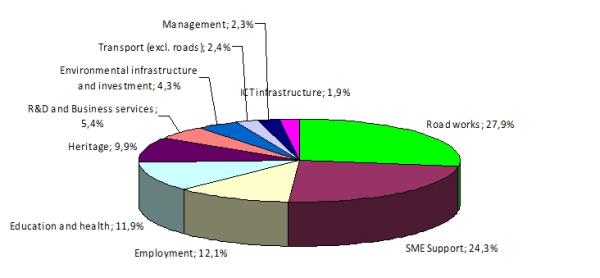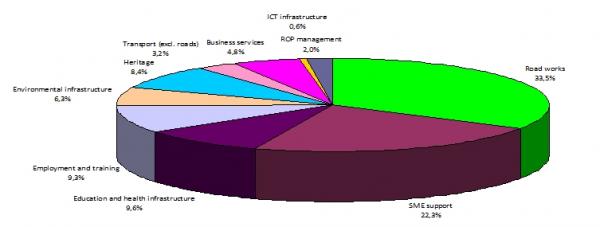Policy context
Regional development policy (including tourism)
| Authors: | Eleni Briassoulis, Alexandros Kandelapas |
| Coordinating authors: | Constantinos Kosmas, Ruta Landgrebe, Sandra Nauman |
| Editors: | Alexandros Kandelapas, Jane Brandt |
Editor's note 3Jul14: Sources D142-3 and D242-4.
Implementation
Regional policy has been the dominant development policy in Greece since the mid-1980s when the country accessed the EU.
Regional policy objectives and procedures are set out in the European and national documents and legal instruments, clearly delimiting the process of implementation. The primary formal implementer of regional policy is the Intermediate Managing Authority of the Region of Crete (IMA Crete). Calls for proposals and project selection are supervised and ultimately effective only after approval by a politically appointed General Secretary (since 2010 the elected Head of the Region). Approval for larger projects may rest on the Ministry of Development or the European Commission and their competent bodies, respectively. Management Authorities and Intermediate Management Authorities of Sectoral OPs (based in Athens) may ultimately implement programmes and projects of a much larger scale and influence than those of the ROP. IMAs are assisted by Monitoring Committees. Other local agencies may function as management authorities and/or beneficiaries of Operational Programmes include ANK (Company for the Support and Development of Cretan Businesses, owned and managed by the Chambers of Commerce, the regional Pancretan Cooperative Bank and the University of Crete) and the Heraklion Development Agency S.A. (HDA, local development agency originally functioning as a Local Action Group for the implementation of the LEADER initiatives) and OANAK (Organisation for the Development of Eastern Crete). Municipalities and prefectures have acquired administrative capacity to become more active in co-financed projects, primarily related to infrastructure (road construction).
The Regional Government (department of investment) processes applications for grants for small-scale private investments. Applications for medium- and large-investments are processed centrally by the relevant departments of the Ministry of Development. Thresholds for the size of investments are generally in flux.
Local Members of the Parliament and other political (party) networks play a significant although informal role in regional policy implementation, functioning as lobbyists in Athens for public or private projects.
Policy instruments affecting and/or implemented in the study sites are primarily financial and include the Regional Operational Programme of Crete, various Sectoral Operational Programmes (SOPs) and the investment law. The sum of Structural Funds spending for the Region of Crete for the 2000-2006 Programming period was €2,285,209,472, out of which €911,905,039 was managed through the ROP.
It is important to note that, at over €1 billion, SF expenditure in the Heraklion Regional Unit alone exceeded the total budget of ROP Crete (€911 million) by more than 10%. This is explained by the function of the city of Heraklion as a regional capital (population, transport the service economy), the presence of the University of Crete and several research centres, the implementation of integrated urban projects and the designation of Heraklion as an Olympic city.
Road works maintain the lion’s share of expenditure (27.9%), followed by SME support (24.3%), employment (12.1%), education and healthcare (11.9%), heritage (9.9%), and R&D and other business services (5.4%).
Total Structural Funds Spending in the Region of Crete, 2000-2006
| Prefecture (Regional Unit) |
Budget For Prefecture (Regional Unit) (Public And Private Expenditure) in € |
| Heraklion | 1,064,830,964 |
| Chania | 477,698,642 |
| Rethymnon | 406,121,835 |
| Lasithi | 336,558,031 |
| TOTAL CRETE REGION (including ROP) | 2,285,209,472 |
| ROP | 911,905,039 |
Source: Authors


For the 2000-2006 period, the ROP-Crete managed over €760 million.
Specifying exact amounts directed to the study sites is far from straightforward. For example, as indicated above, data for private investments support is not available for the municipal level.
Municipality fragmentation, reduced institutional capacity and perverse financial incentives lead to the absence of large-scale and long-term projects from the ROP. Local political strategies tend to depend on short-term results as well as severe competition between municipalities for access to funds. These characteristics lead to a regional equilibrium where the construction of many small roads and the support for many small private investments predominates.
Impacts
At the very least, Structural Funds represent a large cash infusion into the Greek economy, and they have all but replaced the public investment programme. The contribution to physical infrastructure (roads, ICT, schools, universities) has been significant and it is clearly visible in Crete and Heraklion. Attempts to improve environmental infrastructure, such as sewage and waste management, which have had significant positive impacts elsewhere, have been marginal in the study site.
It is difficult to draw conclusions about the study sites: spending is concentrated in the city of Heraklion and the northern axis of Crete and has largely remained outside the study site. The main institutions, contractors and other beneficiaries of regional aid are based in the regional capital. While spill over effects are undoubtedly present, their extent has not been measured.
Institutionally, however, structural funds have engendered several dynamics:
- they have dominated public discourse and politics at all levels. Structural funds' financial incentives have overshadowed, or even hampered, the implementation of other policies such as horizontal environmental and water policy;
- they have diverted attention from organisational and institutional deficiencies;
- they have provided opportunity for corruption, for both politicians and civil servants;
- "hard" physical infrastructure has had adverse impacts on fragile environments, road construction in particular;
- they have introduced new models of project management and competition, facilitating a gradual reform of the public administration. Old actors adapting to these process as well as newly established actors, have gained both prominence and acceptance at the local and regional level.
Effectiveness
Formal regional development goals and objectives are set at the EU level and the effectiveness of the policy is generally best judged at that level.
The contribution of EU Structural Funds to the development (growth) of Messara and the country as whole during the last 20 years is beyond dispute. The country has received unprecedented cash infusions, fuelling investment in public works as well as private enterprises, mainly in the tourism sector. Although in Crete much of this investment has been concentrated in the city of Heraklion, spill over effects undoubtedly exist. In addition, funds directed to Messara are far from negligible and far exceed investment in the area during the previous decades. Investment in the Asteroussia study site has been limited.
With regard to "structural adjustment" however, results can be seen as more mixed. While investment in communications, energy, and transport infrastructure may be seen to contribute in this respect, the underlying productive structures remain largely the same. In Messara, tourism and agriculture persist as the main pillars of the economy with their structural characteristics (small scale family operations) largely unchanged. One could further argue that these characteristics have been solidified through regional policy, which has distributed financial support for small scale businesses (mainly in the tourism sector) through primarily political affiliation criteria.
Indeed, the policy may be seen as especially effective in achieving political hegemony at the national, regional, and local level. This political hegemony has been achieved through fund allocation, contracts for public works, and informal networks for access to investment support at the national, regional and study site level.
